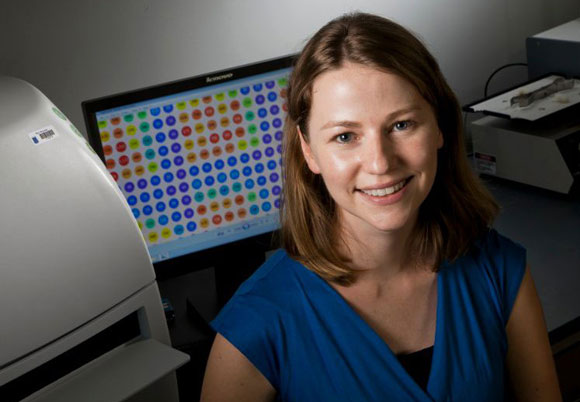
Chemist Emily Derbyshire combines expertise in chemistry with an interest in human health. Photo by Duke University Photography
Emily Derbyshire reaches into a nondescript beige incubator that looks like a dorm room mini-fridge and pulls out a mosquito-filled flask.
The mosquitoes are infected with malaria, an age-old disease caused by a tiny parasite called Plasmodium that spreads from person to person through mosquito bites. Thankfully, these insects carry a strain of malaria that primarily infects rodents, so they pose no threat to people. Instead, they’re helping Derbyshire identify new drugs to treat the disease before symptoms start.
Derbyshire, an assistant professor who joined the faculty at Duke this July,works at the intersection of chemistry and biology to address malaria and other global health problems.
“People often ask me: ‘haven’t we already cured malaria?’” she says.
It’s true that the United States has been malaria-free for more than 60 years, but the disease is still a major killer in Africa, South America and Asia, where nearly one million deaths were reported in 2009. Part of the reason is malaria’s ability to evade attack. Medicines for malaria have been around for hundreds of years, but many of the drugs in the existing antimalarial arsenal are losing their effectiveness as parasite populations in certain parts of the world -- especially southeast Asia -- develop resistance.
“We definitely need to keep searching,” she says.
Derbyshire grew up in Albany, New York, where she fell in love with hiking and camping in the Adirondacks. After attending Trinity College in Connecticut, she moved to California to pursue a Ph.D. in biochemistry at the University of California at Berkeley, where she worked on a human enzyme known to play a role in opening blood vessels and modulating blood pressure.
“I was a chemistry major in college but I’ve always been interested in human health,” she says.
Her pursuit of new malaria drugs began during a postdoc at Harvard Medical School, working on infectious disease under chemical biologist Jon Clardy.
Her focus now is on “small molecules” -- chemical compounds small enough to squeeze through cell membranes. Once inside, they latch onto proteins within the cell and change how the proteins work.
Using a plastic plate roughly the size of an iPhone, Derbyshire is able to screen hundreds of chemical compounds at once to see if they keep malaria parasite growth at bay. Each plate contains 384 little depressions for individual reactions. She takes the parasites from the infected mosquitoes in her lab and mixes them with human liver cells, along with a different small molecule in each well, and uses a luminescent marker to measure how well the parasites grow.
In a recent study she and Clardy identified more than 30 small molecules called protein kinase inhibitors -- some of which are currently in clinical trials to treat cancer -- that curb malaria before symptoms start.
Now that’s she is at Duke, her aim is to figure out how these compounds work.
This summer, Derbyshire received a renewable $249,000 award from the National Institute of General Medical Sciences of the NIH to identify additional small molecules that stunt malaria growth. She hopes to pinpoint which parasite proteins the molecules latch onto and what they do to the proteins' functions.
Derbyshire says the malaria parasite can make more than 5,000 proteins, “around 50 percent of which scientists have no idea what they do because their sequences are so different from any other organism in existing protein databases.”
One of the undergraduates in her lab, Eric Lakey, is working with graduate student Amber Harold on isolating and sequencing key malaria proteins and figuring out how to stop them from working. Another undergraduate, Grace Wang, is building computer models of their 3-D structure.
One day, Derbyshire’s team hopes to do virtual drug screens -- a technique that relies on computer programs rather than 384-well plates -- to rapidly “test” thousands of potential drugs and identify the ones that are most likely to bind and inhibit malaria.
Derbyshire says she loves the fact that when she steps outside her lab in the French Family Science Center, she is just a short walk away from Duke Medicine. Being at a school where the two are so close was a big reason why she decided to come to Duke, where she has a joint appointment in the department of chemistry and the department of molecular genetics and microbiology (MGM) in the medical school.
“It’s great to have them both on the same campus. I feel very fortunate,” she says.